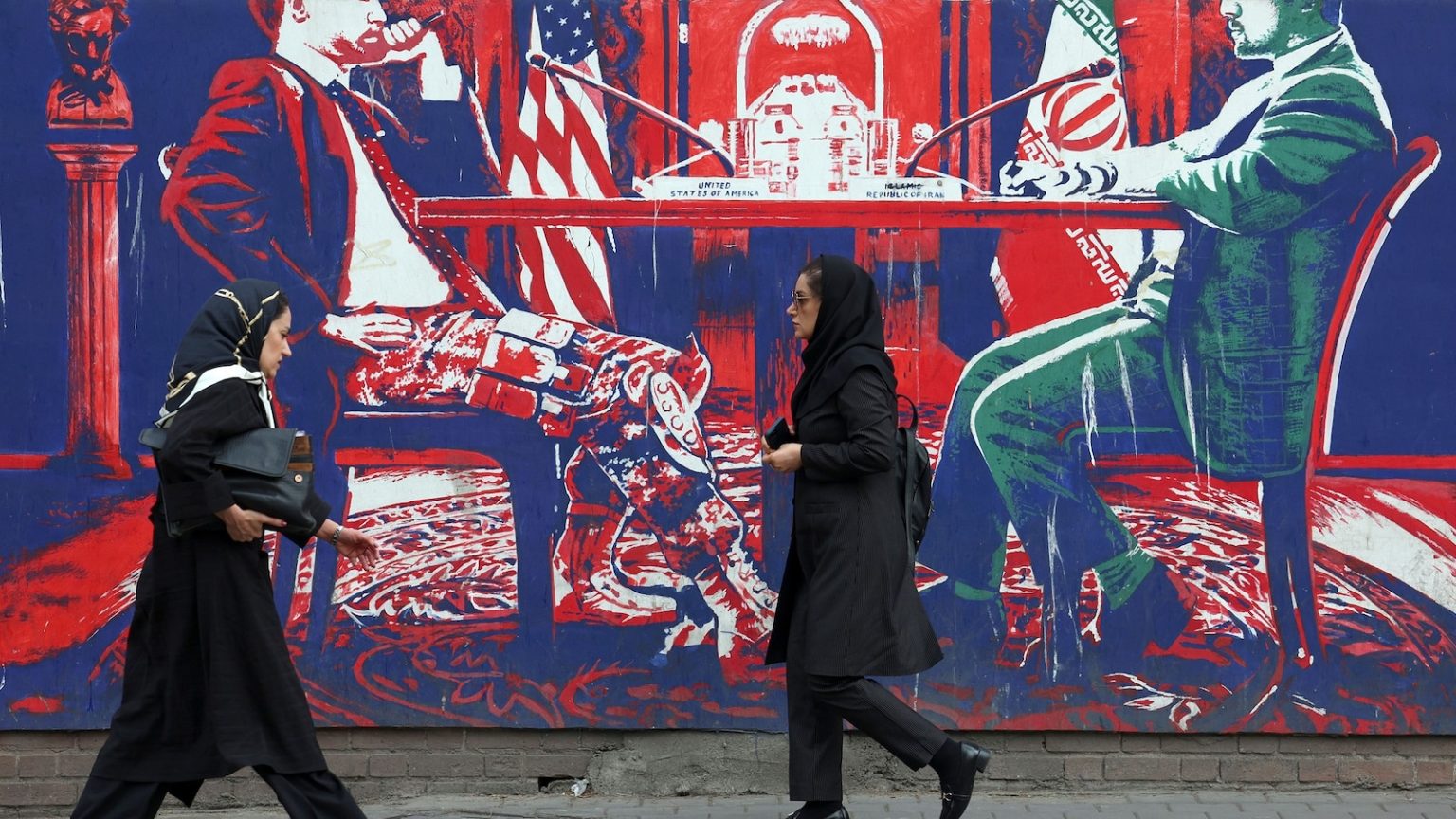High-level delegations from the United States and Iran are meeting over the weekend in Oman to discuss Tehran’s rapidly advancing nuclear program, holding what the White House says will be direct conversations for the first time in seven years.
The meeting comes as experts broadly agree that Iran’s breakout time for amassing enough fissile material to produce a nuclear warhead has dwindled to just one to two weeks — and that Tehran could produce a deliverable nuclear weapon in less than a year.
Despite opening a line of communication with Iran, the Trump administration is playing hardball — with the president himself repeatedly making it clear in the past week that Iran’s alternate option to taking a deal was coming under military attack, setting the stage for a high-stakes diplomatic showdown.
Iranians walk next to an anti-US mural next to the former U.S. Embassy in Tehran, Iran, April 7, 2025.
Abedin Taherkenareh/EPA/Shutterstock
Already at odds?
Ahead of the scheduled meeting, both sides presented different ideas of how the talks would transpire.
From the time President Donald Trump made the surprise announcement that his administration would soon engage with Iran during an Oval Office meeting with Israeli Prime Minister Benjamin Netanyahu on Monday, he was adamant that the two countries wouldn’t rely on an intermediary.
“We’re having direct talks with Iran, and they’ve started. It’ll go on Saturday,” Trump said. “We have a very big meeting, and we’ll see what can happen.”
But officials in Tehran quickly rejected that, with Iranian Foreign Minister Abbas Araghchi saying the meeting on April 12 would be “indirect high-level talks.”
“It is as much an opportunity as it is a test,” he wrote in a social media post on X.
White House press secretary Karoline Leavitt speaks with reporters in the James Brady Press Briefing Room at the White House, April 11, 2025, in Washington.
Alex Brandon/AP
“Well, I have spoken to both the president and also his national security team who will be engaged in these discussions. These will be direct talks with the Iranians,” White House press secretary Karoline Leavitt pushed back on Friday.
“The ultimate objective is to ensure that Iran can never obtain a nuclear weapon. The president believes in diplomacy, direct talks, talking directly in the same room in order to achieve that goal,” she continued.
If the White House’s vision is realized, the talks would mark the first time that delegations from Iran and the U.S. have met face to face since 2018, when Trump exited a nuclear deal with Iran, the Joint Comprehensive Plan of Action (JCPOA), which was brokered during the Obama administration.
New approaches, looming deadlines
When it comes to gaining insight into the Trump administration’s strategy, the format of the talks may not be as significant as the fact that the talks are slated to happen in the first place.
Doreen Horschig, a fellow with the Project on Nuclear Issues at the Center for Strategic and International Studies, and Bailey Schiff, a program coordinator and research assistant for the program, argued the president’s approach to Iran has progressed.
“The Trump administration’s Iran strategy has evolved from a first-term approach focused on maximum economic pressure to a second-term strategy that combines diplomacy, military threats and sanctions,” they said, adding that the game plan now relies on “diplomatic outreach, military posturing and sustained economic pressure.”
Iran’s Foreign Minister Abbas Araghchi attends a joint press conference with his Armenian counterpart following their talks in Yerevan, Armenia, March 25, 2025.
Karen Minasyan/AFP via Getty Images
“What matters is that they’re talking,” Trita Parsi, the executive vice president of the Quincy Institute for Responsible Statecraft, wrote in an op-ed for Time magazine.
Parsi also argued that the timing is critical for Iran and the U.S.
“Despite his aggressive talk and military posturing, Trump cannot afford another major war in the Middle East,” he said. “He has long been a candidate who promises to bring U.S. troops home — not entangle them in a new war.”
Meanwhile, Parsi noted that Iran is up against a potentially worsening economic outlook.
Already limited by extensive U.S. sanctions, Tehran must also contend with the JCPOA’s “snapback mechanism” — a sort of emergency brake built into the deal that allows for United Nations sanctions to be automatically reimposed if Iran violates the terms of the deal.
European countries who are still party to the JCPOA have until Oct. 18 to trigger the snapback function of the agreement and appear increasingly motivated to do so ahead of the deadline.
But given Iran’s fast-tracked nuclear breakout timeline, the U.S. — and other countries that don’t want to see a nuclear-capable Tehran — are also feeling a crunch.
As of now, there’s no indication that the Iranian regime has given the orders to move to the next level when it comes to developing a nuclear warhead, but many U.S. officials assess it is under increasing pressure to do so from hard-liners because of perceived threats to Iran’s security and broader unrest through the Middle East.
Carrots and sticks
Despite a willingness to engage from the Trump administration and economic pressure pushing the Iranian regime, negotiators may struggle to devise a deal that can incentivize all sides, according to former U.S. Ambassador to Israel Daniel B. Shapiro, a distinguished fellow with the Atlantic Council’s Scowcroft Middle East Security Initiative.
“If and when talks get serious, the two sides will face major gaps,” said Shapiro, a former deputy assistant secretary of defense for the Middle East and senior adviser for the State Department’s Bureau of Near Eastern Affairs.
President Donald J. Trump listens to remarks during a Cabinet meeting at the White House in Washington, April 10, 2025.
Shawn Thew/EPA-EFE/Shutterstock
Shapiro noted that Trump, like the Biden administration before him, is seeking a stronger agreement than the JCPOA.
“His aims include fully dismantling Tehran’s nuclear program,” Shapiro said. “Based on all Iranian behavior in previous rounds of negotiations, there is no reason to believe Tehran would agree to these terms.”
Even if Iran did concede, Shapiro argued Tehran would likely expect massive sanction relief — something Congress is unlikely to sign off on.
Trump has indicated that if a deal can’t be reached, combined military action with Israel against Iran is the next option.
“If it requires military, we’re going to have military,” Trump said on Wednesday. “Israel will obviously be very much involved in that. They’ll be the leader of that.”
“He and his team surely know that within a relatively short time, he is likely to face the decision point on whether or not to pursue a military strike,” Shapiro said. “The timing, need and opportunity may never be more compelling.”


